#Passerculus sandwichensis
Explore tagged Tumblr posts
Text
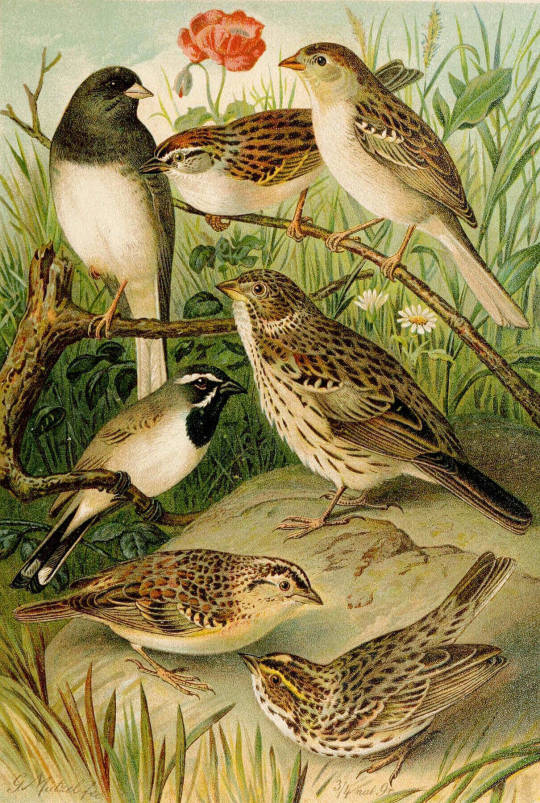
Junco hyemalis | Spizella passerina | Spizella pusilla | Amphispiza bilineata | Pooecetes gramineus | Ammodramus savannarum | Passerculus sandwichensis
Plate XXIII | Die Nordamerikanische Vogelwelt (1891)
#bird art#bird illustration#vintage art#vintage illustration#artists on tumblr#anton goering#new world sparrows#passerellidae#junco hyemalis#dark eyed junco#spizella passerina#chipping sparrow#spizella pusilla#field sparrow#amphispiza bilineata#black throated sparrow#pooecetes gramineus#vesper sparrow#ammodramus savannarum#grasshopper sparrow#passerculus sandwichensis#savannah sparrow
244 notes
·
View notes
Text

Savannah Sparrow
#savannah sparrow#sparrow#Passerculus sandwichensis#Passeriformes#Passerellidae#Passerculus#bird#upl
5 notes
·
View notes
Text

Belding's Savannah Sparrow Passerculus sandwichensis beldingi
6/15/2023 Bolsa Chica Ecological Reserve, California
#savannah sparrow#sparrow#sparrows#new world sparrows#passerellidae#bird#birds#bird photography#birblr#wildlife#wildlife photos#wildlife photography#nature#nature photos#nature photography#birding#birdwatching#birding photos#my photos#california#california wildlife
672 notes
·
View notes
Text

Savannah Sparrow (Passerculus sandwichensis), Willcox, Cochise County, Arizona.
123 notes
·
View notes
Text
The State Birds Initiative: Massachusetts (#6)

Whoa, it's December already? Wow! Been a while since I made one of these, but I honestly needed the break I think. So, uh...where were we? Ah, right.
Welcome to the sixth official poll of the State Birds Initiative! Before the poll, though, one thing real quick, and I cannot emphasize this enough! Read the post below before voting in the poll! It's not a requirement, but it is a real firm suggestion, especially important if you're lacking context about the birds being presented as the new (or old) State Bird of the Bay State, Massachusetts. This is to be fully informed as to why these are being presented, and to make your choices appropriately. Lastly, some of these birds, you will notice, *may *go against some of the rules listed in the introduction post. All is explained after the jump where the explanations are, I promise you that. With that...OK! Here's the poll!
Welcome to the sixth official poll of the State Birds Initiative! Before the poll, though, one thing real quick, and I cannot emphasize this enough! Read the post below before voting in the poll! It's not a requirement, but it is a real firm suggestion, especially important if you're lacking context about the birds being presented as the new (or old) State Bird of the Bay State, Massachusetts. This is to be fully informed as to why these are being presented, and to make your choices appropriately. Lastly, some of these birds, you will notice, may go against some of the rules listed in the introduction post. All is explained after the jump where the explanations are, I promise you that. With that...OK! Here's the poll!

Massachusetts, baby! I've had to travel away from the Bay State in the past week for a conference, but I'm excited to get back to this surprisingly great state. I say surprisingly because Massachusetts' reputation isn't a greatest for those outside of it, but living in it has definitely changed my mind for a number of reasons! That said, the time has come to talk about it a bit. The sixth smallest state in the union, Massachusetts is home to a number of prominent cities, both historically and contemporaneously. There is of course, Boston, the capital and largest city seen above via the big-ass CITGO sign. And while that's the city people equate with the entire state, let's not forget Worcester, Springfield, Cambridge, Lowell, Plymouth, Salem, Amherst, Natick, Cape Cod, etc., etc., etc. There's a whole-ass pile of classic New England cities in this small state, as well as a bevy of habitats and natural spaces.
So, to get into it a bit, Massachusetts is smack-dab in the New England temperate forests, with the highlands dominating the western portion of the state, and a flat lowland coastal region in the eastern half. Forests are temperate mixed, which contributes to the legendary falls that we see in New England. The coastal regions, meanwhile, are glacial in origin, covered in wetlands towards the center of the state, and beaches on the shores. Also of note are the various coastal marshes throughout the state, which serve as their own predominant habitats. Using the BioMap2 project as a framework, let's talk a little bit about these habitats.
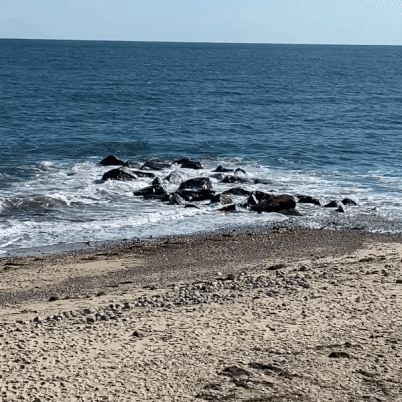
Massachusetts, of course, sits on the Atlantic Ocean, which certainly isn't a first for this list, but is vitally important as we go further north into New England. In the case of Massachusetts, we're looking at sandy beaches and dune habitats as prominent foraging and nesting areas for various shorebirds, which does make shorebirds a high likely focus for this list. Some of you probably know one of the most important birds we'll be looking at, but we'll get to that one, don't worry.
Alongside the beaches, estuaries are a prominent habitat along the shorelines. Places like Plum Island, in northern Massachusetts, or Belle Isle Marsh in the middle of Boston itself, personally come to mind. Massive saltmarshes that are vital stopover habitats for migrants, habitats for insects and endangered turtles, and coastal salt ponds and tidal marshes that house incredible biodiversity within them. There's a lot of focus coming to the coastlines, that's what I'm saying. All of these habitats and the species within them comprise about 41,000 acres of land, and about 75% of that is in danger from development and rising sea levels.
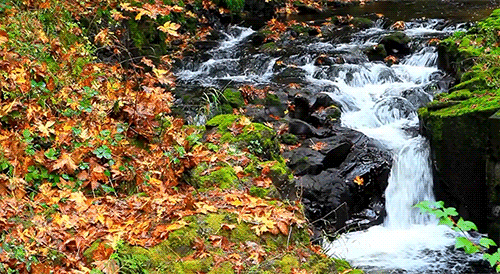
Now, I'm gonna skip over a bunch of other habitats here, especially freshwater wetlands and riparian habitats, because while these are extremely important, they won't be getting as much focus here. Now, we need to move on to the forests. I've talked about them before in Connecticut, New Jersey, and Pennsylvania, but we've got a very specific situation here in Mass. Here, because of the large number of people and settlements, fragmentation is a very prominent problem in the state. For the uninitiated, habitat fragmentation is basically what it sounds like: splitting up habitat by roads or other man-made corridors, breaking up populations of several animals, birds included. Doesn't sound like a big deal to animals that can fly, but birds don't like crossing corridors if they can help it, because it makes them vulnerable to predation (of adults and nests) and car strikes. So, forests of New England and Massachusetts are a habitat of needed focus. And while this will receive a slightly lesser focus, most likely, it's still a place we'll take a look at.
These three habitat types, wetland, coastal, and forest, are the most important in Massachusetts, as well as in New England (which, again, will change slightly as we head further north). But there's also the ever-important human element to consider, ESPECIALLY here.

While I said Boston doesn't define the entire state, and it doesn't, it's also the second most populated city on our list of states thus far, and happens to be one of the most important places in the country historically. Let's not forget, this is basically the seat of the American Revolution in many ways, so it's a pretty major part of our cultural identity as a country. And trust me, Boston is fully aware of that fact. I'm never one to dabble in stereotypes, but Bostonians are extremely proud to be Bostonians most of the time. It's a proud city, and that's understandable from a traditional point of view.
Plus, with Plymouth Rock 40 minutes to the south (and not worth the drive, from what I've heard), the textile-based seat of the American Industrial Revolution 40 minutes to the north (looking at you, Lowell), the site of the "shot heard round the world" 15 minutes away (Concord and Lexington, of course), the oldest American university 5 minutes away (Cambridge, of course), and the home of the legend of the American witch about an hour north (Salem, of course)...look, it's a central hub of the state, and it WILL not be ignored! So, with that said, grab some coffee from Dunks and some clam chowdah, let's settle in and check out some birds!
If anybody has a suggestion that I hadn't brought up here, send it my way! I will absolutely add another poll if there are entries I think could bear fruit. But, in the meantime, read on if you're interested in the possible choices for the State Bird of Massachusetts!
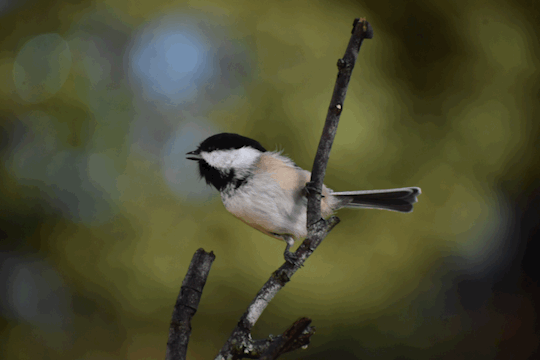
Black-capped Chickadee (Poecile atricapillus)
I gotta say, I have a real soft-spot for these guys. Although, to be fair, I think most people do! Named after their iconic call, and their memorable black cap, the Black-capped Chickadee (Poecile atricapillus) is one of the most iconic birds of New England, and arguably of North America. I say arguably only because there are a few chickadees in the United States, but the Black-capped is one of the most famous. We'll revisit the rest in two later posts, but this one is our focus today.
This bird was originally chosen because, well, it's iconic. I assume. To be honest, I don't actually know why it was chosen, outside of it being recognizable. It's also possible (POSSIBLE) that it was inspired by nearby Maine's choice of State Bird. But that's a choice we'll get to at a later date, I promise you that. As for the BCCH here, does it fit the state? I'll be honest, I actually like the chickadee for Massachusetts' State Bird. Partially, that's because it's a bird that can be found all throughout it with no difficulty, and it's an excellent beginner bird for kids (and just-starting amateurs). But, it's also small and incredibly scrappy, just like Massachusetts. I've had these guys in hand before, and I tell you, these little bastards'll hammer away at your cuticles with their beaks to get you to let them go. Doesn't hurt, unless they really try to grab on and twist at a sensitive spot, but they're fighters!

They're also quite social and vocal, which also fits residents of the Bay State. They have a unique language, with an alarm call that's recognizable by multiple bird species for warning, and it's also their most famous call ("chick-a-dee-dee-dee-dee"). The more "dees" there are, the higher the perceived threat is, fun fact. They hang out in groups in the winter, both with other chickadees and other birds, and their brains generate new neurons in the autumn and winter to remember and navigate to places where they can find food during a difficult harvesting season. That's how I feel when I have to remember where the nearest Dunks is for coffee, not gonna lie.
I realize that I'm making some convincing arguments for the incumbent here, but...yeah, there's a reason. I do honestly think this is a solid choice for the State Bird of Massachusetts, so I'll support its re-election if that occurs. But with that said and presented, let's move on to the challengers. Some are good, some are mediocre, and some are a bit surprising. And some...should maybe belong to a different state.
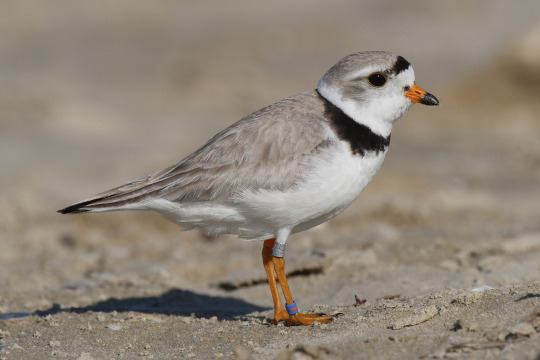
Piping Plover (Charadrius melodus)
eBird's suggestion is, unsurprisingly, the Piping Plover (Charadrius melodus), because a whopping 25% of the breeding population can be found in Massachusetts, according to eBird Status and Trends. And WOW, that is a massive proportion. That means, just to make this clear, one in 4 of ALL Piping Plovers are born in Massachusetts. Significant proportion, meaning that this has a claim on the role of MA State Bird for that reason alone. And Massachusetts certainly knows this, as several beaches in the state are shut down during the plover breeding season to allow them to nest in peace, without human disturbance.
In fact, when Piping Plovers were declared endangered in the Endangered Species Act, Mass Audubon launched the Coastal Waterbird Program to protect them and a later entry on this list. The population has exploded tenfold in the last 40 years of conservation work, and these are a pretty easy to find species now, if you're looking for them. This is a great introductory bird, both to conservation efforts, and to shorebirds (which are notoriously difficult to identify). It's also, surprisingly for shorebirds of this ilk, pretty easy to identify. And also...they're incredibly cute. I mean, have you seen the babies? It's crazy how cute they are. Seriously, LOOK AGAIN. Precious. Another solid candidate, and an excellent representative of the beaches of Massachusetts.
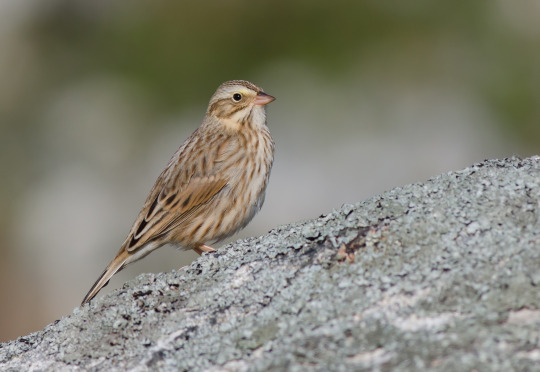
Ipswich Sparrow (Passerculus sandwichensis princeps)
Ah, the Savannah Sparrow (Passerculus sandwichensis). We meet again. Sorry to abandon you back there in Georgia, but to be fair, you were only nominated there because you're named after a major city in the state. But here...ah, wait, right, same thing. Now, to be fair, you've probably mentioned that the nominated bird is the Ipswich Sparrow (Passerculus sandwichensis princeps), not the Savannah Sparrow. But this is, of course, a subspecies of the Savannah Sparrow, named after Ipswich, Massachusetts due to its first sighting there. Larger and paler than its compatriots, the Ipswich Sparrow is known from Massachusetts...but breeds in Nova Scotia. Yeah, we've got another Connecticut Warbler (Oporornis agilis) situation here. Yikes.
So, is there a reason to nominate this bird for Massachusetts outside of its name? Well...actually kinda. These pale sparrows are, to be fair, pretty uniquely found in Massachusetts. And, while this isn't the only place you can see it, it is a reliable place to find it. It's sighted on the dunes on the Massachusetts coast, blending in with the light-colored sand, and making its way to and from Nova Scotia, where it only breeds on one island. So, conservation concern (and focus), seen in the state (even if it doesn't breed there), relies on some of its habitats of focus (saltmarshes and coastlines), has a tie to it that's unique to Massachusetts...it's something. Not as good as other options, but...something. In any case, let's move on.

Snowy Egret (Egretta thula)
Hold on. We saw this guy in the Connecticut post! What is this post, a bunch of repeats? Well, to be fair here, the Snowy Egret (Egretta thula) is a slightly better fit for Massachusetts than it was for Connecticut...for the exact same reason it was suggested for Connecticut. Well, part of it, anyway. I stand by the idea of applying the "macaroni" label to the Snowy Egret to fit with Connecticut, but it's the Audubon Society part I'm focusing on here. Lemme quote the previous post:
To be clear here, quite a lot of birds were used in millinery back in the day, but the Snowy Egret (and the Great Egret (Ardea alba), for that matter) are special. Those long white feathery plumes were heavily prized as hat decorations, enough so that the species nearly went extinct from hunting them for the hat trade. As a result of that, people began to turn their eye towards conservation of the species, and the protection of birds in general. Two women, Harriet Hemenway and Minna B. Hall, got a group of women together to protect the birds. They rallied the troops, and their organization became fairly popular. Eventually when they sought to name it, they did so after one of the most famous ornithologists in American history at the time: John James Audubon. And from there...well, you can guess.
The Audubon Society is one of the premiere bird conservation organizations in the world, and especially in the United States, and is well-known to the public sector. And it was born right here in...Massachusetts. Oh. Wait, have I jumped the gun on this one?
I had, indeed, jumped the gun. So, to fix that now, let's throw the Snowy Egret in here instead! After all, it does breed in the state (a little bit), and I actually saw some earlier this year in Parker River NWR! It has a historical tie, and to the largest conservation organization in New England! Trust me, Mass Audubon is a MASSIVE deal up here, and their link alone gives me cause to put the Snowy Egret on this list. That said, though...that's not their logo.

Common Tern (Sterna hirundo)
To my genuine surprise, the logo for Mass Audubon is actually the Common Tern (Sterna hirundo), an aerial and acrobatic seabird found on the shores of Massachusetts, in some surprising places. In Massachusetts, though, there's a major tie to conservation and the Common Tern, because this is actually one of the birds whose feathers were stolen for hats, inspiring the foundation of the movement. Yeah, both the Snowy Egret and this species, which was (and is) more common here. So, if there's an Audubon-related bird to be elected, it probably should be this one, to be honest. This is a species, understand, that was crashing in population in the late 1800s, and was saved from hunting by a young Mass Audubon. Between 1889 and 1920, the population bloomed eightfold, from 5,000 pairs to 40,000 pairs. An impressive population boom in every possible way. However, that wouldn't last.
Herring Gulls (Larus argentatus), human activity, and various other disturbances have created numerous population crashes and bottlenecks in the species' history in Massachusetts, keeping them a conservation focus to this day. The species has notably spread throughout the state's coastlines to this day, and they aren't terribly hard to find. In fact, you can see them in the Boston Harbor, from the shore! I've seen Common Tern from the New England Aquarium very often, in fact, and it's sort of magical to see them smack-dab in the middle of the city. Their habitats of beaches and shorelines need to be maintained and protected, so throwing the conservation focus on them is incredibly valuable for the species' future. A solid choice for State Bird (or another category sponsored by the SBI), if ever there was one.

Veery (Catharus fuscescens)
But wait, coming in at the last moment, just making it, the Veery (Catharus fuscescens)! Yeah, this one's a bit of a surprise, but I found out some very interesting info recently. The Black-capped Chickadee (Poecile atricapilla) was not the first nominee for State Bird; instead, in 1931, the State Federation of Women's Clubs (yup, another woman's organization) nominated the Veery for the State Bird...and got shot down. It took them ten years to nominate the Chickadee for unknown reasons, meaning the Veery probably didn't even get its day in court. Shameful! So, let's try and rectify that here, shall we?
Veery are thrushes, famous for the beautiful, ethereal calls that give them their name. This is a robin-sized migratory songbird that breeds in the forests of New England and southern Canada, and are an iconic New England bird in their own right. They're found in forested wetlands (that's two habitats of concern in MA), usually fairly close to beaver ponds, and the two species are often associated. It's also a species mentioned in Henry David Thoreau's Walden, one of the most important environmentalist literary works in American history, as well as an important Massachusetts story. It's also currently spreading in the state, increasing the size of its range, while also experiencing slightly decreasing populations, meaning that focus is still needed. And again...that song. It's a delight to hear it in forests, and recognizing it is a great step for beginning birders to pay more attention to the sound around them.

And with that...yeah! We'll end it there! Only six nominees, and you're probably wondering what's happened to the State Raptor and State Game Bird. Well...I'll explain that once we get to the results. Because that's a bit more complicated then expected.
See you next time, and happy birding!
Introduction to the State Birds Initiative
1. Delaware - Poll | Results 2. Pennsylvania - Poll | Results 3. New Jersey - Poll | Results 4. Georgia - Poll | Results 5. Connecticut - Poll | Results 6. Massachusetts - Poll | Results
#bird#birds#birding#birder#birders#birdwatching#black birder#state bird#state bird initiative#state birds initiative#birdblr#birblr#poll#tumblr poll#birds of tumblr#black-capped chickadee#piping plover#snowy egret#ipswich sparrow#common tern#veery#chickadee#plover#egret#sparrow#tern#thrush#massachusetts#birdposting
64 notes
·
View notes
Text
Week 4 Observations
1.22.25
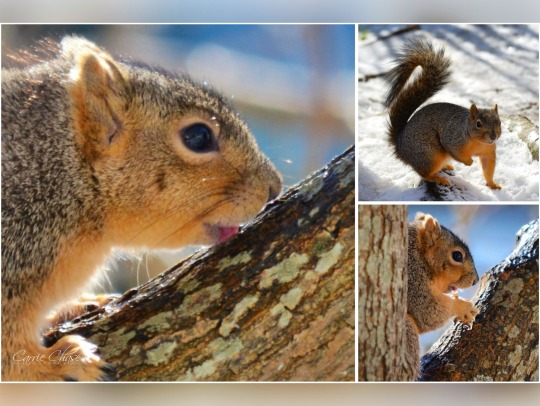
Fox Squirrel
Sciurus niger
Observed in the snow, eating a snack and licking ice on a tree limb at home on Galveston Island 1.22.25. You can see its tongue 😛
They are native to North America and is the most common of tree squirrels. They are on the invasive alien species of Union concern list in Europe.
Their whiskers, claws, abs and more help them navigate their environment. The habitat they thrive in the most are areas with tall trees and little to no understory. They live in leaf nests or tree dens (preferred).
Fun fact: they can jump 15 feet horizontally and free fall to a soft landing of 20 feet or more!
#foxsquirrel #Sciurusniger #citizenscience #mammal #outdoors #nature #squirreltongue #native #january #january22 #2025 #picoftheday #project365 #day22
1.23.25
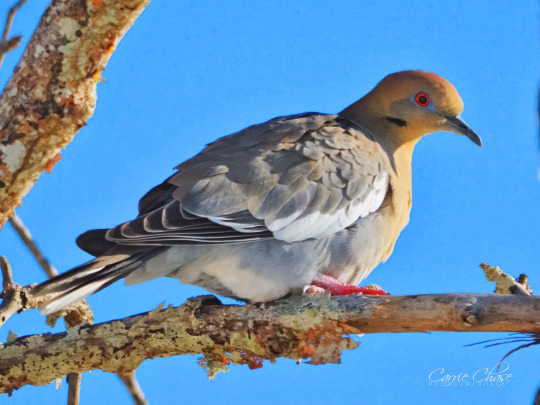
White-winged Dove
Zenaida asiatica
Their native range includes the Southwestern US and down to Central America and has expanded to Texas and surrounding states due to humans providing a reliable food source. Before agriculture exploded they stuck to their native range because their primary food/water source was the saguaro cactus.
I observed this one and its friends in a tree at my home on Galveston Island 1.22.25.
Though this species has lost nesting colonies, is on the wild game list and suffered a population collapse in the 1960s & 1970s it appears to have bounced back and is good at adapting to life with humans.
#whitewingeddove #Zenaidaasiatica #citizenscience #bird #nature #outdoors #january #january23 #2025 #picoftheday #project365 #day23
1.24.25

Dunlin
Calidris alpina
Observed these non breeding adults at Galveston Island State park 1.21.25.
While they winter along the coast they migrate to the arctic tundra to breed.
The population is very big and have a status of “least concern” yet appears to be decreasing and there are some subspecies that are quite endangered.
These birds forage for food on coastal mudflats and sandy beaches in flocks by poking their slightly curved bill in and out of the sand/mud. What’s cool about this is that their bill become a sensitive probe when an area on the end of the bill fills with blood and works with nerve endings that helps locate food.
#dunlin #Calidrisalpina #citizenscience #birds #water #nature #outdoors #january #january24 #2025 #picoftheday #project365 #day24
1.25.25

Savannah Sparrow
Passerculus sandwichensis
Observed near Galveston Island State Park on 1.23.25.
They’re common to Texas and winter here. Then they fly north to breed.
This one was foraging for seeds and insects in the grass.
Their nests are usually hidden very well on the ground in grass or weeds.
Fun fact, they often return to the same area where they hatched from each year!
#savannahsparrow #Passerculussandwichensis #citizenscience #bird #nature #outdoors #january #january25 #2025 #picoftheday #project365 #day25
1.26.25

Common Raccoon
Procyon lotor
Observed on the east end of Galveston Island on 1.26.25. There’s a huge committee (collective noun) of raccoons that live there, probably because people feed them. Usually their diets consist of a mix of plants and different animals.
They are native to North America. They’ve adapted past their original habitats and can be found almost anywhere in North America.
The most important sense they have is touch with highly sensitive front paws. They’re are very smart and studies have shown they are able to remember a solution to a problem for up to 3 years!
#commonraccoon #Procyonlotor
#citizenscience #raccoon #mammal #outdoors #nature #january #january26 #2025 #picoftheday #project365 #day26
1.27.25
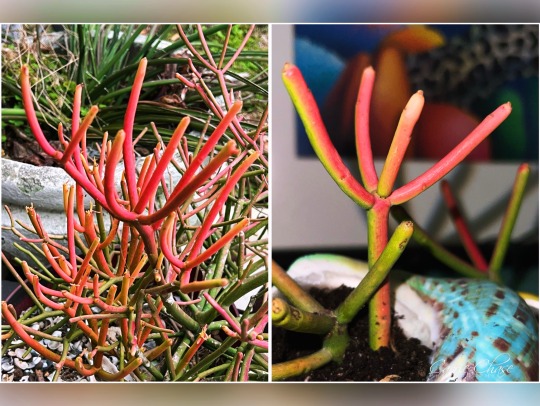
Firestick
Euphorbia tirucalli
My friend gave me a few cuttings from her plant. I am not a plant person so we’ll see how this goes. It’s very pretty though.
It’s native to Africa and not invasive here but makes for a pretty ornamental plant.
It’s interesting she has this plant because it thrives well in a low humidity area 😆 The more I learn about this plant the less I think I’ll be able to keep it alive.
It produces a latex (sticky plant fluid) that is quite toxic but is also used to feed cows in places. Makes me wonder about the cows!
#firestick #Euphorbiatirucalli #citizenscience #succulent #plant #outdoors #indoors #nature #january #january27 #2025 #picoftheday #project365 #day27
1.28.25
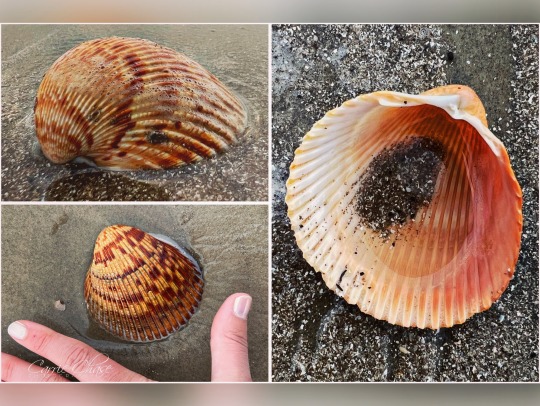
Giant Atlantic Cockle
Dinocardium robustum
This large, saltwater clam can be found all along the North American coast, the Gulf of Mexico and in the Caribbean. This particular shell was observed on Galveston Island beach 1.26.25.
We’ve been having extreme low and high tides and these beautiful shells are usually found when the tide is very low.
They use their foot to burrow into the sand and also “leap” away from predators like sea stars!
Though this shell was just one half I have been lucky enough to come across some that still had their inhabitants.
#giantatlanticcockle #Dinocardiumrobustum #citizenscience #shell #beach #nature #outdoors #january #january28 #2025 #picoftheday #project365 #day28
#citizen science#outdoors#nature#fauna#mammal#native#fox squirrel#animal#white-winged dove#birds#dunlin#savannah sparrow#common raccoon#raccoon#omnivore#firestick#succulents#flora#plants#giant Atlantic cockle#shell#beach#bivalve#mollusk
3 notes
·
View notes
Text


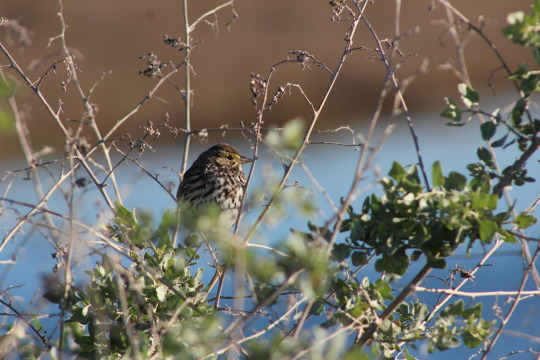

Savannah Sparrow - Passerculus sandwichensis
Orange County, CA, Jan 9, 2024
These guys are definitely missing their calling as models.
1 note
·
View note
Photo


Savannah Sparrows (Passerculus sandwichensis)
48 notes
·
View notes
Photo
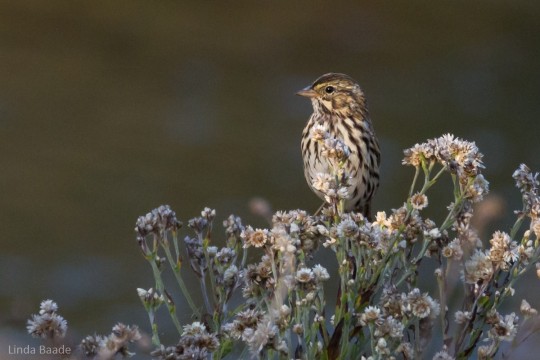
Savannah Sparrow (Passerculus sandwichensis)
© Gerry and Linda Baade
29 notes
·
View notes
Video
From the archives Via Flickr: Savannah Sparrow (Passerculus sandwichensis) at Ridgefield National Wildlife Refuge
#Animal#Bird#Clark County#Passerculus sandwichensis#Ridgefield National Wildlife Refuge#Savannah Sparrow#Sparrow#Washington
2 notes
·
View notes
Photo

Savannah Sparrow, Passerculus sandwichensis (by me)
#Savannah Sparrow#Passerculus sandwichensis#Passerculus#Passerellidae#Passeroidea#Passerida#Passeri#Passeriformes#Psittacopasserae#Eufalconimorphae#Aves#birds#sparrow#autumn#Monmouth Battlefield State Park#Monmouth County#New Jersey#mine
15 notes
·
View notes
Photo

A new variant has been added!
Savannah Sparrow (Passerculus sandwichensis) © Edwin L Sheppard
It hatches from absent, coastal, dark, distinctive, extensive, indistinct, open, short, unique, and yellow eggs.
squawkoverflow - the ultimate bird collecting game 🥚 hatch ❤️ collect 🤝 connect
1 note
·
View note
Photo

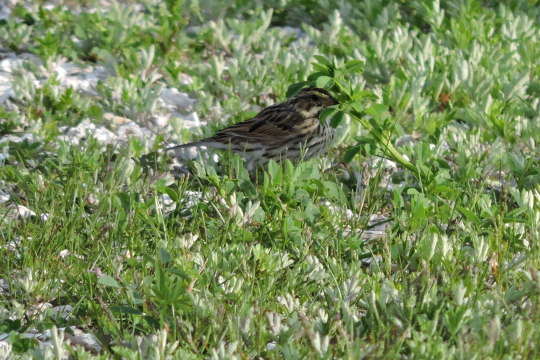

Savannah Sparrow, Passerculus sandwichensis
8 notes
·
View notes
Text

Vesper Sparrow and Savannah Sparrow Pooecetes gramineus and Passerculus sandwichensis
12/10/2023 Riverside County, California
#vesper sparrow#savannah sparrow#sparrow#sparrows#new world sparrows#passerellidae#my photos#bird#birds#nature photography#wildlife#nature#bird photography#wildlife photography#birding#birdwatching
38 notes
·
View notes
Text
World Sparrow Day March 20
Savannah Sparrow Passerculus sandwichensis
Swamp Sparrow (Melospiza georgiana)
Song sparrow Melospiza melodia
Tree Sparrow Spizelloides arborea
Savannah sparrow Passerculus sandwichensis
Swamp Sparrow (Melospiza georgiana)
What is the name of these Sparrows featured above?
The present is full of opportunity. Never before in the history of the planet has mankind been given the privileges and opportunities that are at his disposal today. A great light has been raised and is penetrating the darkness of the world, but alas, too many with dust blinded eyes have yet to catch the vision. Some of us have. That is our privilege and our responsibility. ~Richard St. Barbe Baker.
What do Harris’ Sparrow, White-crowned Sparrow, White-throated Sparrow, Fox Sparrow, Swamp Sparrow, Savannah Sparrow, Baird’s Sparrow, Vesper Sparrow, American Tree Sparrow, Chipping Sparrow, Clay-coloured Sparrow, Song Sparrow and Lincoln’s Sparrow all have in common? These labels include all these species as sparrows celebrating World Sparrow Day March 20! These species of Aves belong to the sparrow family Passeridae; the true sparrows, or Old World sparrows. Passerines compared to other birds have a unique arrangement of their toes, three pointing forward and one back, which facilitates perching – giving rise to their name a perching birds.
“Sparrows are difficult for people to identify because they don’t look at sparrows very often and so they are out of practice when it comes to actually looking carefully at their markings. But when it comes to identifying sparrows, there are two traits to study closely: song, and facial plumage pattern.Mystery” Which of these sparrows are common, and which are of special concern and which are threatened and on the verge of extinction? 1./ Learn. 2./ Experience 3./ Do Something: ***
The Harris Sparrow (Zonotrichia querula) may be mistaken for a House Sparrow, though the House Sparrow has a black or yellow bill, and the Harris Sparrow sports a pink bill. The Harris Sparrow belongs to the genus Zonotrichia, a greek word whose etymology means zone = “band”, and thrix, trikhos = “hair.” Zonotrichia are part of the family Emberizidae in the order Passeriformes. The Harris has a much longer tail than a House Sparrow, and the House Sparrow (Passer domesticus) has rufous (reddish-brown similar to rust) colouring on the wings and on the back, Both House Sparrows and Harris Sparrow have dark bibs, however the Harris Sparrow features black stripes below their bib. In the Saskatchewan prairies, Harris Sparrow also resemble White-throated Sparrow, and Song Sparrows. The Harris will breed in coniferous forests choosing spruce trees, and migrate through tallgrass prairies. The Harris will average a length of 17 to 20 cm (6.7 to 7.9 in), with a 27 cm (11 in) wingspan and weigh from 26 to 49 g (0.92 to 1.73 oz) with a tail length 7.6 to 8.8 cm (3.0 to 3.5 in). Compare this large sparrow to its smaller cousin, the House Sparrow 16 cm (6.3 in) long, weighing in at 24–39.5 g (0.85–1.39 oz) with a short tail tail 5.2–6.5 cm (2.0–2.6 in) long.
White-crowned Sparrow (Zonotrichia leucophrys) is one of the easiest sparrows to identify with its distinctive black and white stripy head. Leucophrys derives from leukos, “white”, and ophrus, “eyebrow”. The White crowned sparrow, though distinctive with its black and white markings on the head, does indeed, have a white crown on the top of its head, in contrast with the white and black head of the Harris’s Sparrow which features a black crown, and white below, and does not look stripy at all.
White-throated Sparrow (Zonotrichia albicollis) has a delightful call, often related among bird watchers as Oh Sweet Canada, Canada, Canada. This is a very common sparrow, but its highest mortality rate is due to window collisions. The White-throated sparrow, is just that, white throated, no stripes, or colourations on its chest, and features a small bright white bib below its bill. The head sports distinctive white and black stripes, however the yellow patches above its bill separates this species from the White-crowned sparrow. The White-throated Sparrow weights in at 22–32 g, with a length 16–18 cm and wingspan 20–23 cm.
Red Fox Sparrow ( Passerella iliaca iliaca ) is another large sparrow commonly seen along the ground. This sparrow is 15–19 cm (6–7.5 inches) long, featuring a wingspan of 27 cm (10.5 inches) and an average weight of 32 grams (1.1 oz). It is the typical “little brown bird”.
Swamp Sparrow (Melospiza georgiana) belongs to the order Passeriformes, and love to forage and breed along marsh edges. This sparrow features a solid coloured grey breast, with a rust or rufous cap and rusty wings. There is a dark stripe through the eye. The easiest way to tell if you are observing a Swamp Sparrow is to watch its tail, which it flicks from side to side all the time.
The savannah sparrow (Passerculus sandwichensis) is a steaky brown bird, featuring a small yellow spot above the bill near the eye. They feature a white chest, with a stripy bib. The feathers fluff on top of the head to make a small peak. The average length is between 11 to 17 cm (4.3 to 6.7 in), featuring a wingspan from 18 to 25 cm (7.1 to 9.8 in) and a body mass at 15 to 29 g (0.53 to 1.02 oz). This bird can also be found along the ground or in low bushes. Generally, the Savannah sparrow is considered a threatened species by the International Union for Conservation of Nature IUCN.
Baird’s Sparrow (Ammodramus bairdii) is in the Emberizidae of order Passeriformes. The Baird’s Sparrow has a length 12 cm and weigh in at 17-21 g and have a wingspan usually around 23 cm. Baird’s is somtimes confused with the Savannah sparrow however, the Savannah is much more streaked and features an extra white marking on its head. The Baird breeds and forages in the tallgrass prairies, and mixed grass prairies. The numbers of the Baird Sparrow are decreasing, and this is a concern to ornithologists as the Canadian prairies are the world’s most endangered ecosystem. Last Committee on the Status of Endangered Wildlife in Canada COSEWIC Designation of the Baird’s Sparrow was special concern. As the native prairie grassland disappears, then what will happen to the Baird’s Sparrow? It usually takes an experience bird watcher to identify a Baird’s Sparrow. Naturalists have found that populations of Baird’s Sparrow flourish after a controlled burn. Take time to learn the song and colour patterns of the Baird’s Sparrow “The Baird’s Sparrow is a secretive grassland sparrow, distinguished from other sparrows by “moustache” marks on its yellowish-ochre face, a necklace of thin streaks across its breast, and a song that usually ends in a wiry, musical trill. As a range-restricted species of the northern prairies, it is a valuable grassland indicator for that region. Species at risk
Vesper sparrow (Pooecetes gramineus) is a medium to large sparrow across the grassland prariries. It is unique as its song can often be heard in the golden hour of the day, early morning and in the vesper twilight hour at the end of day. It is another typical grayish brown bird, featuring a white eye-ring similar to that of a Robin. The Savannah Sparrow has a much shorter tail, and where the Savannah has a yellowish eye band, the Vesper does not. The Song Sparrow does not sport a distinctive white eye rings. There are four sub-species of Vesper Sparrows, and the Vesper Sparrow affinis subspecies is believed to be down to only five to ten pairs of birds.
American Tree Sparrow (Spizelloides arborea) is one of the sparrows seen in the winter in the prairies. American Tree Sparrows have a rufous crown, stripy rufous back and wings, and also a rufous eye stripe. They sport a white chest with a small pale black spot. One of the main differences between an Amerian Tree Sparrow and Chipping Sparrow is the rufous eye strips in the American Tree Sparrow, and the Chipping has a black eyestripe. The American Tree Sparrow breeds in the arctic boreal zone, and will be seen migrating across the plains near forest edges and near marshes. The American Tree Sparrow typically weighs in at 18 to 26 g, and are about 14 to 16.5 cm long with a wingspan range from 21.6 to 24.8 cm.
Chipping sparrow (Spizella passerina) are about 127 to 147 mm in length, and weigh in at 11 to 15.5 g. They will often be seen amid juncos, and clay-coloured sparrows. Chipping sparrows may perch atop a tree to survey their territory. A Chipping sparrow has pink legs and feet, and a black bill on top, with a pink or yellow under fill. They feature a black eye-stripe below a chestnut crown. Chipping sparrows have grey chest and rump with stripy wings sporting two broad white bands across them.
Clay-coloured sparrow (Spizella pallida) is one of the smaller sparrows, average length is 5.1–6 in (130–150 mm), weight 12 g (0.42 oz), wingspan 7.5 in (190 mm) and tail 62–68.4 mm (2.44–2.69 in). May often be seen perched on the tops of low growing thickets of brush and the nests are quite often within snowberry bushes. These little brown birds have a buff grey underbelly, with a gray colour encircling the entirety of its neck as a collar. The head and back or streaks of tan and black. A white stripe goes over its eye, and there is a small black moustache above the bill.
Song sparrow (Melospiza melodia) is a small brown bird of the family Emberizidae in the Passeriformes order. On average this sparrow is 11 to 18 cm (4.3 to 7.1 in) in length, with a wingspan can range from 18 to 25.4 cm (7.1 to 10.0 in), weighing in between 11.9 to 53 g (0.42 to 1.87 oz). Cornell Lab of Ornithology states that, “it’s one of the first species you should suspect if you see a streaky sparrow in an open, shrubby, or wet area.” Don’t confuse it with the Savannah Sparrow which has a yellow fleck on its face. The song sparrow is most common in brush areas and along marshes and a mix of the two is ideal. The song sparrow has a delightful mix of songs and melodies.
Lincoln’s Sparrow, (Melospiza lincolnii) loves to be around marshy areas, and dense thickets and is easy to spot with the streaks radiating all the way down its underbelly and no spot on the belly. It is the typical little brown job with a grayish, to brown stripy body much lighter in colour than the darker Song Sparrows. The bill of the Lincoln’s Sparrow is dark above, with a paler colour blow and featuring two rufous stripes through the crown.
As Jason Ward says, “Sparrows—or “little brown birds” (LBBs) as birders like to call them—are tricky like that. They’re always zooming in and out of bushes, confounding onlookers with their bland feathers and busy chatter…Tackling the common LBBs is a fun way to challenge yourself and sharpen your birding skills. With a little patience and a keen eye and ear, you will soon have your sparrows down to a science. Ward” For a little more assistance while walking along the wetlands and woodlands of the Richard St. Barbe Baker Afforestation area just download these bird field guides to your phone; What bird on IPhone What bird on Android
The fate of an individual or a nation will always be determined by the degree of his or its harmony with the forces and laws of Nature and the universe. Man is not alone in the universe but is surrounded by sources of power, harmony and knowledge. The fullness of life depends upon man’s harmony with the totality of the natural cosmic laws. Our individual evolution is a job that has to be carried on day by day by each individual himself. It is a lifelong task.” ~Richard St. Barbe Baker.
BIBLIOGRAPHY:
American Tree Sparrow All About Birds. Cornell Lab of Ornithology
American Tree Swallow Wikipedia.
American Tree Swallow Audubon Field Guide
American Tree Sparrow Bird web
American Tree Sparrow Feeder Watch
American Tree Sparrow What Bird
American Tree Sparrow Birds of North America.
American Tree Sparrow American Tree Sparrow Facts. National Geographic
American Tree Sparrow Kids inquiry of Diverse species, Spizella arborea, Amercian Tree Sparrow. BioKids
American Tree Sparrows in Winter. Wild Bird Video Productions.
Baird’s Sparrow Life History. All About Birds. Cornell Lab Of Ornithology
Baird’s Sparrow. What Bird
Baird’s Sparrow Audubon. US Fish and Wildlife Service
Baird’s Sparrow. Wikipedia.
Baird’s Sparrow. Audubon Field Guide
Birdist Rule #23 Identify Your First Song Sparrow Once you do, all of those other “little brown jobs” get a little less confusing. Audubon.
Chipping Sparrow National Geographic
Chipping Sparrow BioKids. Kid’s inquiry of Diverse species Spizella Passerina, chipping sparrow information.
Chipping Sparrow All about Birds. Cornell Lab of Ornithology
Chipping Sparrow Audubon Field Guides
Chipping Sparrow Wikpedia.
Chipping Sparrow Wild Bird Video Productions.
Clay-coloured Sparrow. All about Birds. Cornell Lab of Ornithology
Clay-coloured Sparrow Audubon Field Guide
Clay-coloured Sparrow Wikipedia
Clay-coloured Sparrow Whatbird
Clay Coloured Sparrow On identifying Chipping and Clay-coloured Sparrows. Sibley Guides
Clay Coloured Sparrow. Whatbird.
Clay Coloured Sparrow Singing You Tube Petroglyph 100
Bond, Larry. Fox Sparrow. You Tube
Chipping Sparrow bird web.
Fox Sparrow. Fox Sparrow pictures Fox Sparrow Facts. National Geographic
Fox Sparrow. Birdweb.org Seattle Audubon Society
Fox Sparrow. Audubon Field Guide
Fox Sparrow. Bird Watcher’s Digest
Fox Sparrow All About Birds Cornell University.
Fox Sparrow Bird of North America Online Cornell University.
Fox Sparrow What bird
Harris’ Sparrow All About Birds Cornell University.
Harris Sparrow. Wikipedia.
Harris Sparrow What Bird. Mitch Waite Group. Percevia field guides.
Harris Sparrow. Audubon Field Guide. National Audubon Society
Langston, Erica. Why City Sparrows Are Singing A Very Different Tune Birds are belting their songs out at never-before-heard frequencies to beat the heavy noise around them. Audubon Field Guide. National Audubon Society
Lincoln’s sparrow Calls and sounds Lesley the Bird Nerd. You Tube video
Lincoln’s Sparrow. All About Birds. Cornell Lab of Ornithology
Lincoln’s Sparrow Audubon Field Guide
Lincoln’s Sparrow Wikipedia.
Lincoln’s Sparrow. Bird Web
Lincoln’s Sparrow Melospiza lincolnii ARKive.
Lincoln’s Sparrow, Melospiza lincolnii. videos, photos and sound recordings. The internet bird collection. HBW Alive
Mystery bird: Clay-coloured Sparrow. Spizella Pallida Girl Scientist. Science The Guardian.
Savannah Sparrow All about birds. Cornell Lab of Ornithology.
Savannah Sparrow Wikipedia.
Stewart, Marilyn. Savannah Sparrow You Tube
Savannah Sparrow Audubon Field Guide
Savannah Sparrow. You Tube
Song Sparrow All about birds. Cornell lab of ornithology
Song Sparrow wikipedia
Song sparrow Audubon Field Guide
Song Sparrow National Geographic
Song Sparrow Bird Web
Song Sparrow Wild Bird Watching.
Song Sparrow What bird.com
Song Sparrow Lang Elliot. You tube video
Stop birds hitting windows. Effective Window Solutions. American Bird Conservancy.
Swamp Sparrow Identification All about Birds. Cornell Lab of Ornithology.
Swamp Sparrow Wikipedia.
Swamp Sparrow Audubon Field Guide
Swamp Sparrow video Wild Bird Video Productions.
Swamp Sparrow What bird.
Vesper Sparrow All About Birds. Cornell Lab of Ornithology.
Vesper Sparrow Wikipedia
Vesper Sparrow Audubon Field Guide
Vesper Sparrow Species at Risk Registry.
Vesper Sparrow What Bird
Vesper Sparrow Wild Bird Video Productions.
Ward, Jason. The biggest differences between song and savannah sparrows. Audubon Bird Identification Guide
White-crowned Sparrow All About Birds Cornell University.
White-Crowned Sparrow National Geographic
White-crowned sparrow. Wikipedia
White-crowned sparrow What Bird. Mitch Waite Group. Percevia field guides.
White Crowned Sparrow. Audubon Field Guide. National Audubon Society
White-throated Sparrow All About Birds Cornell University.
White-throated Sparrow Wikipedia.
Lang Elliott. White-throated Sparrow: Whistler of the North You Tube
White-throated Sparrow. National Geographic
White-throated Sparrow. American Bird Conservancy.
White-throated sparrow All About Birds Cornell University.
White-throated Sparrow Explore the Birds of North America. All About Birds Cornell University.
White-throated Sparrow. The National Bird Project. Canadian Geographic
Why Canada’s prairies are the world’s most endangered ecosystem Nature Conservancy of Canada.
For directions as to how to drive to “George Genereux” Urban Regional Park
For directions on how to drive to Richard St. Barbe Baker Afforestation Area
For more information:
Blairmore Sector Plan Report; planning for the Richard St. Barbe Baker Afforestation Area, George Genereux Urban Regional Park and West Swale and areas around them inside of Saskatoon city limits
P4G Saskatoon North Partnership for Growth The P4G consists of the Cities of Saskatoon, Warman, and Martensville, the Town of Osler and the Rural Municipality of Corman Park; planning for areas around the afforestation area and West Swale outside of Saskatoon city limits
Richard St. Barbe Baker Afforestation Area is located in Saskatoon, Saskatchewan, Canada north of Cedar Villa Road, within city limits, in the furthest south west area of the city. 52° 06′ 106° 45′ Addresses: Part SE 23-36-6 – Afforestation Area – 241 Township Road 362-A Part SE 23-36-6 – SW Off-Leash Recreation Area (Richard St. Barbe Baker Afforestation Area ) – 355 Township Road 362-A S ½ 22-36-6 Richard St. Barbe Baker Afforestation Area (West of SW OLRA) – 467 Township Road 362-A NE 21-36-6 “George Genereux” Afforestation Area – 133 Range Road 3063 Wikimapia Map: type in Richard St. Barbe Baker Afforestation Area Google Maps South West Off Leash area location pin at parking lot Web page: https://stbarbebaker.wordpress.com Where is the Richard St. Barbe Baker Afforestation Area? with map Where is the George Genereux Urban Regional Park (Afforestation Area)? with map
Pinterest richardstbarbeb
Facebook Group Page: Users of the George Genereux Urban Regional Park
Facebook: StBarbeBaker
Facebook group page : Users of the St Barbe Baker Afforestation Area
Facebook: South West OLRA
Twitter: StBarbeBaker
You Tube Richard St. Barbe Baker Afforestation Area
You Tube George Genereux Urban Regional Park
Should you wish to help protect / enhance the afforestation areas, please contact the City of Saskatoon, Corporate Revenue Division, 222 3rd Ave N, Saskatoon, SK S7K 0J5…to support the afforestation area with your donation please state that your donation should support the Richard St. Barbe Baker Afforestation Area, or the George Genereux Urban Regional Park, or both afforestation areas located in the Blairmore Sector. Please and thank you! Your donation is greatly appreciated.
1./ Learn.
2./ Experience
3./ Do Something: ***
“St. Barbe’s unique capacity to pass on his enthusiasm to others. . . Many foresters all over the world found their vocations as a result of hearing ‘The Man of the Trees’ speak. I certainly did, but his impact has been much wider than that. Through his global lecture tours, St. Barbe has made millions of people aware of the importance of trees and forests to our planet.” Allan Grainger
“The science of forestry arose from the recognition of a universal need. It embodies the spirit of service to mankind in attempting to provide a means of supplying forever a necessity of life and, in addition, ministering to man’s aesthetic tastes and recreational interests. Besides, the spiritual side of human nature needs the refreshing inspiration which comes from trees and woodlands. If a nation saves its trees, the trees will save the nation. And nations as well as tribes may be brought together in this great movement, based on the ideal of beautifying the world by the cultivation of one of God’s loveliest creatures – the tree.” ~ Richard St. Barbe Baker.
Nature is man’s teacher. She unfolds her treasure to his search, unseals his eye, illumes his mind, and purifies his heart; an influence breathes from all the sights and sounds of her existence. Alfred Billings Street
Assemble yourself with wild things, with songs of the sparrow and sea-foam. Let mad beauty collect itself in your eyes and it will shine – Calling me. For I long for a man with nests of wild things in his hair. A man who will Kiss the Flame. – Jewel
Sparrows: difficult to identify World Sparrow Day March 20 What is the name of these Sparrows featured above? The present is full of opportunity.
#American Tree Sparrow#Ammodramus bairdii#Baird&039;s Sparrow#Chipping Sparrow#Clay-coloured Sparrow#George Genereux Afforestation Area#George Genereux Urban REgional Park#Harris sparrow#Lincoln&039;s Sparrow#little borwn birds#little brown jobs#Meewasin#Meewasin Valley Authority#Melospiza georgiana#Melospiza lincolnii#Melospiza melodia#Passerculus sandwichensis#Passerella iliaca iliaca#Pooecetes gramineus#Red Fox Sparrow#Richard St. Barbe Baker#Richard St. Barbe Baker AFforestation ARea#Richard St. Barbe Baker Park#Saskatchewan#Saskatoon#Savannah Sparrow#Song Sparrow#Spizella pallida#Spizella passerina#Spizelloides arborea
0 notes
Text
The State Birds Initiative: Georgia (#4)
Welcome to the fourth official poll of the State Birds Initiative! Before the poll, though, one thing real quick. My suggestion is that you read the post below before voting in the poll below. That's especially important if you're lacking any context about the birds being presented as the new (or old) State Bird of the Peach State, Georgia. This is to be fully informed as to why these are being presented, and to make your choices appropriately. Lastly, some of these birds, you will notice, may go against some of the rules listed in the introduction post. All is explained after the jump where the explanations are, I promise you that. But with that...OK! Here's the poll!
With that...time to put Georgia on our minds!

Georgia! State of peaches, Coca-Cola, pecans, and civil rights! Home of Ray Charles, Jimmy Carter, Jackie Robinson, and the great Martin Luther King, Jr.! Location of the only whale shark in captivity in the country, the historic Forsyth Park of Savannah, the majestic Stone Mountain, and the first Chick-fil-A! And for our purposes here in the State Bird Initiative, it's also the first state we're looking at with a tropical climate! Well, a humid subtropical climate, actually, but it counts! If you've ever been to Georgia (which I haven't as of yet, but I'm working on that), you probably know that Georgia is a bit sweaty and temperate most of the year, with long humid summers and high water levels.
In terms of the ecology of the state, we're looking at swamps, cedar-dominated, as well as having a decent proportion of pine trees. Actually, to be specific, we're looking at forests of Longleaf Pine (Pinus palustris), an large endangered pine tree species endemic to the southeastern United States. Now, to be clear, this species isn't specific to Georgia, and it's actually the state tree of Alabama. However, now that we've hit the southern USA, we have to address it, as the tree is a symbol of the region. The actual state tree of Georgia is another iconic tree to the southeastern USA, the Southern Live Oak (Quercus virginiana), another big tree evolved to be resistant to forest fires, saltwater, and hurricane-force winds common in the area. Famously, the Southern Live Oak trees of St. Simons Island, Georgia was harvested for the density of their wood, which made them particularly strong against cannonballs. Said wood was used to construct the famous U.S.S. Constitution, AKA "Old Ironsides", which was said to have cannonballs actually bounce off of it throughout the War of 1812. Said ship is still in Boston Harbor to this day, making the 227-year old ship the oldest still floating naval warship in the world! And that's all thanks to the natural environment of Georgia.

What about Georgia's culture? Historically, of course, Georgia is complicated as hell. A former seat of the Civil War and the Confederacy, the state has seen heavy reconstruction in the last century and a half, eventually becoming associated with many civil rights heroes, and currently having a few prominent bastions of the Democratic Party, such as Atlanta. On a contemporary level, the state is famous for its music, its accents, and its food! The state has at least four foods as state symbols - peaches, peanuts, grits, and the Vidalia onion, and has other iconic food and drink like sweet tea, cornbread, peach cobbler, and fried catfish.
As for its people, they're a highly religious bunch on average, known for their hospitality and, according to some accounts online, "polite sarcasm". Y'know, "bless your heart" and all that. Conservative historically with an increasing population of Black Democrats in metropolitan centers, it's a growing state in terms of diversity, and changing rapidly. So...a culturally diverse bird that lives in oak trees? Yeah, that's a target we're gonna hit for sure. I mean, the oak or pine tree part is pretty easy, but the other thing? Well..a songbird would make some sense. I mean, the state is famous for its musicians, ranging from OutKast to Gladys Knight to 2 Chainz to Luke Bryan, and more. So, something that sings is a solid choice. There are a couple of other qualities we can go for, but that's enough for now, I think.

With that, let's move onto the choices. Got some interesting ones this time, but I have...a hunch about this one. We'll see how this goes, but I have a feeling it's gonna go the way of New Jersey's poll, which has been...decisive. But OK, with that...birds after the jump!!!
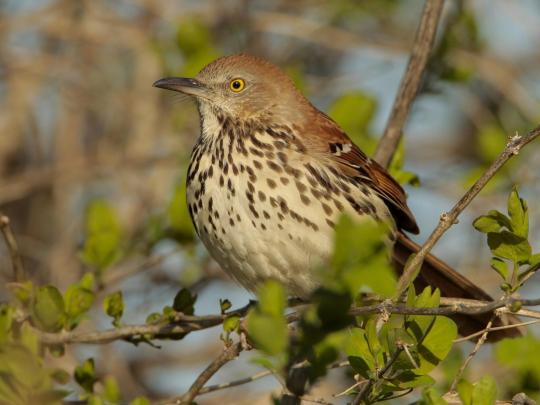
Brown Thrasher (Toxostoma rufum)
Not gonna lie - this one could be hard to beat, surprisingly. Which is too bad for a number of reasons, but the Brown Thrasher (Toxostoma rufum) isn't really a horrible choice for Georgia's State Bird. It breeds in the state, even though it's found all over the eastern and central USA. It's an iconic bird in sight and sound, which is pretty important for a state that's produced a lot of human singers. I even mentioned up above that a songbird wouldn't be a bad choice, and what better songbird than one who can memorize, mimic, and remix multiple sounds for its own use? Plus, it was chosen by school kids, meaning it was elected by the public. Of course, to be fair, it was also chosen by governor at the time, Eugene Talmadge, a famous white supremacist who enforced segregation in Georgia schools and universities, openly supported Adolf Hitler, and was a genuinely extremely racist PIECE OF SHIT...but I digress? Although, it is extremely ironic that Talmadge ratified the Brown Thrasher as the State Bird of Georgia, so there's that.
OK, Talmadge doesn't really have anything to do with this, I just needed to get some anti-racist anger out for a second there, sorry; dude was a bastard in a lot of ways. But in terms of the Brown Thrasher, it's honestly not a bad choice for Georgia. Thing is...I'm not entirely sure I can say it's the best choice, or even a really good choice, frankly. It's...a choice. It does eat peaches, though, so maybe throw that into the pros pile for the species. Oh, and one more thing: it's defeated an attempt to depose it before. The frankly kinda ridiculous attempt to change the State Bird of Georgia to the Cornish Chicken in 2010 was not received well for the chicken. Georgians liked their Thrasher too much! Also, one of the arguments against the Brown Thrasher that the Flip the Bird movement put forth was that it "has no contribution to the state of Georgia economy". Of all the stupid goddamn arguments...
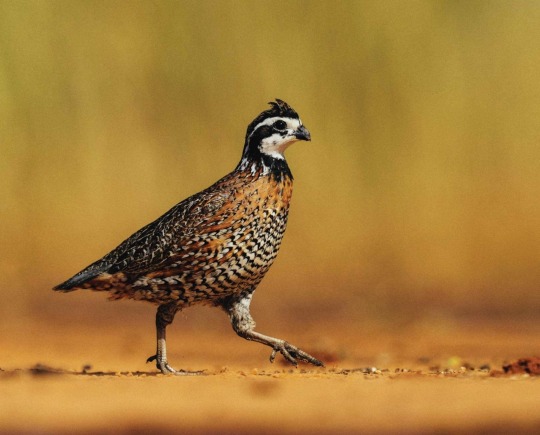
Northern Bobwhite (Colnius virginianus)
Well, if we're talking about the incumbent State Bird, we should bring up the incumbent State Game Bird as well! Yeah, this'll be a regular thing going forward. Any ornithological state symbols are up for bid and re-election, although this is a slightly different process. If a State Game Bird is elected as State Bird, it will ascend to that post, and a new State Game Bird will be proposed, possibly with a new poll. However, if it is not the chosen State Bird, it'll remain as the State Game Bird. So, really, the Northern Bobwhite gets to stay where it is...for now. This may change as we get overlapping game birds across the USA. And we will, believe me. With that said, let's talk about the Northern Bobwhite (Colinus virginianus).
A member of the New World quails (Odontophoridae) the bobwhite is named after its iconic whistling call, and not a random dude named Robert White. The Northern Bobwhite isn't the only species of bobwhite quail by any means, but it's the only major native representative in the USA. It's a grassland and open forest-loving quail whose range extends from Texas to Massachusetts...kind of. Here's the problem with the bobwhite: its population is rapidly decreasing. In the past 60 years or so, the population's decreased by at least 85% in its native range, which is...A LOT. It's partially for that reason that the species is on my priorities for my Life List, because I've never seen them, and they're rapidly vanishing.
youtube
That, alongside the normal ecological concerns and links, and its relatively new status as a threatened species due to land use and forest fires, makes it a good candidate for recognition on its own. But is it a good bird for Georgia? Well, only 4% of its breeding population is found in the state year-round, making the state a poor reservoir for the species. There's also a point that the bobwhite is, surprisingly, an invasive species in some countries, specifically New Zealand and Italy. They're also a common bird in captivity, even though any aviary should have them be the only ground-dwelling bird, since they can be aggressive to competitors. That said, they're not a completely doomed species.
More importantly, though, the fact that Georgia doesn't have a lot of these guys immediately makes them a less-than-ideal candidate for State Bird. State Game Bird, though? That might actually be worse. Remember, this is an endangered species, meaning it may not be a bird we should glorify as a food source. In fact, the Georgia Department of Natural Resources has conservation measures in place to protect bobwhite and their habitat, also seeking to restore it and add new potential habitats for the species. And they aren't eliminating hunting of the species, but are strictly managing and monitoring populations. And there is merit to managed hunting, for the record, but that's a separate conversation to be had. So, not a horrible choice to remain as Game Bird. But who knows? Maybe I'll make a separate poll to ask this question after all. If that's something that interests you, let me know! For now, let's move on.

Bachman's Sparrow (Peuacea aestivalis)
On to the eBird suggestion! And this one is...ooooooooh...yikes. OK, yeah, you may remember my issue with the Saltmarsh Sparrow (Ammospiza caudacutus) as a potential State Bird for New Jersey, mostly revolving around the idea that it wouldn't be easily recognizable by the public, unaffiliated with sparrows and their subtle or major differences. This? This is worse. Once again, don't get me wrong, Bachman's Sparrow (Peuacea aestivalis) would be a dream for me as a birder, as a southern exclusive species and a lifer for me personally. But for the average layman? This is a bird difficult to identify for birders! Not sure the average non-bird person has a chance, to be honest.
But just to be completely comprehensive, why the Bachman's Sparrow? Well, the eBird article quotes the species as having a large breeding population in Georgia. However, to be completely fair, the species mostly breeds in Florida, not Georgia (48% vs. 30%, by recent calculations). That said, the number of Bachman's Sparrows breeding in Georgia isn't a number to sneeze at. As for its ecology, it specializes in pine forests, including those composed of longleaf and loblolly pine, which have Georgia as a major habitat. Oh, and on a historical note (not that this matters too much), John Bachman was an opponent of segregation and racist eugenics beliefs, so a lot better than other historical figures with birds named after them. Granted, that bar is buried seven feet beneath the Earth, but still, it's cleared in this case. So, not the worst set of reasons for Bachman's Sparrow to make the cut.

Savannah Sparrow (Passerculus sandwichensis) Swamp Sparrow (Melospiza georgiana)
Whoa whoa whoa, hold on, hold on. Two more sparrows? What is this, karma? Well, yeah, maybe. Of course, these two are chosen based on their names, as both specimens used in the descriptions for the species were collected in Georgia. But does this truly matter in this case? Neither the Savannah Sparrow (Passerculus sandwichensis), nor the Swamp Sparrow (Melospiza georgiana), breed in Georgia, although both are still found in the state. If I had to argue one over the other personally, it'd be the Swamp Sparrow, both to represent a dominant habitat in the state, and because they're possibly more recognizable...even though they're pretty close to the Song Sparrow (Melospiza melodia) to the untrained eye, I suppose.

Brown-headed Nuthatch (Silla pusilla)
See, here's the real question about the eBird choices. Why choose the Bachman's Sparrow, when the adorably charismatic Brown-headed Nuthatch (Silla pusilla) was right there? The largest breeding population of this bird's global range is in Georgia, with a full 26% of the species depending on Georgia for its propagation. Yeah. This is definitely a Georgia breeder, but since the Bachman's Sparrow is a bit more endangered, has different living conditions, and is a bit more dependent on its Georgia population than the nuthatch here, that's likely why it was given the crown.
And yet...AND YET...in my opinion, this is the better state-dependent representative for Georgia. Sure, less of its breeding population is found in Georgia, but one-quarter of its global population isn't exactly something to sneeze at. And, importantly, this is where the majority of its population is housed, making Georgia more important for the Brown-headed Nuthatch than it is for the Bachman's Sparrow. But is it a better representative outside of that point? Well, it's recognizable, it's not terribly difficult to find, and it's certainly charismatic. I mean, look at that thing, it's cute as hell! Not that the sparrows aren't cute in their way, but the nuthatch? I wanna squeeze that thing, and apparently, they actually sound like rubber duckies. And no, charisma doesn't always mater, and it can be damaging for noncharismatic species conservation. But it can help.
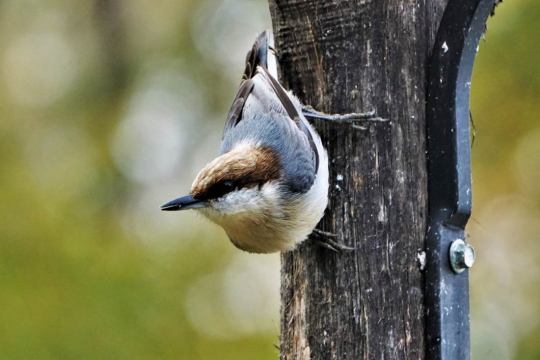
Anything else? Well, using the same logic I have with other birds, it's an important representative of its habitat. The pine forests of the Southeastern USA are, unsurprisingly, in trouble. In fact, longleaf pine forests are kind of a massive deal from a conservation standpoint, and they're in a massive amount of trouble due to development and climate change. Some figures calculate a 95% loss of these forests by 2080, which is...bad, it's real bad, obviously. That kind of potential danger to their habitat, combined with their role within it, makes the nuthatch a good option. And apparently, Birds Georgia agrees with me.
Birds Georgia, for the record, is formerly known as the Georgia chapter of the National Audubon Society. And, while they still have affiliation to the organization, they've separated themselves from the legacy of its namesake. Credit where credit's due! Anyway, why bring them up? Birds Georgia has a number of species they highlight for conservation focus, with the Brown-headed Nuthatch being a major example. Their nestbox program focuses on building more nestboxes for a declining species across the state, and it's very much worked! 450 nest boxes have been installed across the state since 2015, and hopefully that doesn't stop! So, cute potential representative! But that's not the only conservation focus from Birds Georgia.

Chimney Swift (Chaetura pelagica)
From 2019 to 2020, Birds Georgia named the Chimney Swift their Conservation Focus for the year, and began an initiative to have nestboxes put out for the species across the state. Multiple towers were erected throughout the state by multiple conservation initiatives working with Birds Georgia, giving the birds more habitats outside of direct human settlements to breed and thrive in. But, why the Chimney Swift? They're sort of all over the place.
If you're from the eastern USA and walked outside in the morning or late afternoon, you've probably heard random chittering high above you, especially if you're in a city or town with chimneys on their buildings. If you look up, you've probably seen silhouettes of these guys flying at high speeds in the sky, mouths open to gather flying insects in the dawn and dusk. These are common birds all over the eastern US, as well as recognizable and easy to find and hear. So, why suggest them for Georgia? Because Georgia is tied with three other states for having the largest proportion of the breeding population for the species, at 6% of the species. Not a high number, but a significant proportion nonetheless. That makes it an intriguing choice for Georgia...and a few other places. So, this is probably not the last time we see this species on the polls.

Red-headed Woodpecker (Melanerpes erythrocephalus)
But hey, if we're going for birds elevated by Birds Georgia, then we should probably highlight their actual mascot: the Red-headed Woodpecker (Melanerpe erythrocephalus). We've already talked about the importance of woodpeckers as keystone species in forested environments, and the Red-headed Woodpecker is definitely an example of that ecological role. In truth, the Pielated Woodpecker (Dryocopus pileatus), which was up for the Pennsylvania poll, actually widens holes made by the Red-headed Woodpecker for its own nest-cavities, meaning a keystone depends on a keystone.
Now, in terms of Georgia's population, the breeding population in the state is definitely not the bulwark for the species (that trophy belongs to Kansas with 11%), but the live oak forests the state is seeking to protect definitely houses the species in significant numbers state-wide. The reason Birds Georgia uses it in their logo is because, in 2014, the species was considered high-risk and on the decline in its range. As of 2022, the species is also suffering its highest region-wide decline in Georgia, tied with a few other states on that front well. Combine these facts with an iconic appearance, and the Red-headed Woodpecker is also a decent choice for State Bird from a conservation standpoint.
OK...one more. And this one's...a stretch.

Red-Shouldered Hawk (Buteo lineatus)
OK, it's not actually a stretch; I just wanted to say that because it's a tall image, and I thought it'd be funny. So, OK! The Red-shouldered Hawk (Buteo lineatus). Now, this is yet another species you can find in various places in the eastern USA, but its second largest breeding population in the country can be found in the Peach State, which is beat out by Florida. Trust me, though, Florida is one of the big three states in the South in terms of breeding bird populations. I try to get a raptor for each state, you'll notice, but why this raptor for Georgia, outside of the breeding population thing?
Well, firstly, there's the association of the species with swamps and woodlands, both of which are prominent Georgia habitats. They've got an extremely varied diet, going for most small prey items in their ranges, even weird ones like roadkill deer, crayfish, and screech owls. And while they're most common in Georgia, they're also most certainly seen in Georgia fairly commonly, especially after their recovery from DDT. But even then...why? Why have a hawk for the state of Georgia at...OK, some of you probably figured it out, I might as well just say it now.

Yup, Georgia's basketball team is the Atlanta Hawks. And yes, OBviously I could've gone for the Atlanta Falcons, but falcons make far less sense to highlight for the state, ironically. There are only three commonly seen species in the state, and none of them have Georgia as a major highlight of their breeding ranges. So, with that in mind, the Hawks seem like the team to highlight, and the best hawk for the state of Georgia is the Red-shouldered Hawk. With that said, is this really the best choice for Georgia's state bird? I mean...that's up to Georgians (and Tumblrites) to decide in the end.
So! An odd post, this one was. Some interesting choices in the end, but is this the most solid roster? Not sure. I have my guess as to the winner for this one, and honestly...it's not a bad choice if I'm right. But with that, it's time to leave it to you - the people! And the next time we have one of these posts, we'll be heading to a region and a state near and dear to me, personally. Time for the Nutmeg State, and the first state with a frequent flyer for a state bird!

See you soon, and happy birding!
Introduction to the State Birds Initiative
1. Delaware - Poll | Results 2. Pennsylvania - Poll | Results 3. New Jersey - Poll | Results 4. Georgia - Poll | Results 5. Connecticut - Poll | Results 6. Massachusetts - Poll | Results
#bird#birds#birding#birder#birders#birdwatching#bird watching#black birder#state bird#state bird initiative#georgia#birblr#birdblr#state birds initiative#brown thrasher#northern bobwhite#quail#bachman's sparrow#sparrow#swamp sparrow#savannah sparrow#brown-headed nuthatch#chimney swift#red headed woodpecker#red-shouldered hawk#hawk#atlanta hawks#bird tumblr#long post#poll
38 notes
·
View notes